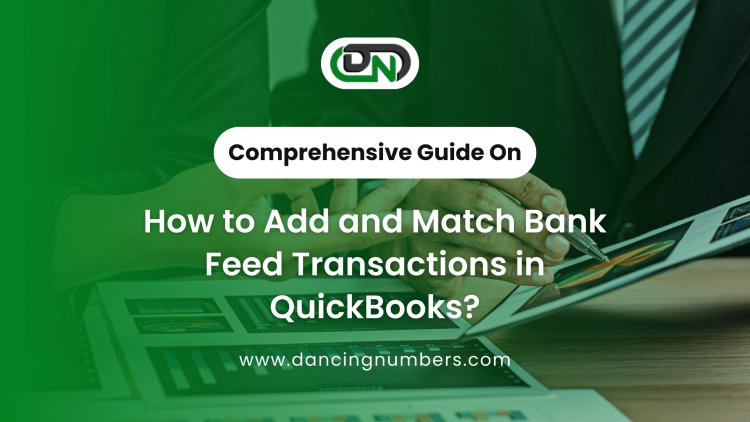How to Add and Match Bank Feed Transactions in QuickBooks: A Complete Guide
Learn how to efficiently add and match bank feed transactions in QuickBooks. This step-by-step guide will help you streamline your bookkeeping, ensuring your financial records are accurate and up to date.
Share this Post to earn Money ( Upto ₹100 per 1000 Views )

Managing your business finances can be complex, but QuickBooks simplifies this process significantly through its bank feed feature. This powerful tool automatically imports your bank transactions, allowing you to review, categorize, and reconcile them with ease. In this guide, we’ll walk you through the process of adding and matching bank feed transactions in QuickBooks, ensuring your accounting remains precise and efficient.
What Are Bank Feeds?
Bank feeds are a QuickBooks feature that links your bank account to the software, automatically importing your financial transactions. This means less manual data entry and a lower chance of errors, making your accounting process smoother and more accurate.
Step 1: Connect Your Bank Account
Before you can add or match transactions, you need to link your bank account to QuickBooks.
-
Log In to QuickBooks:
- Open your QuickBooks account and go to the main dashboard.
-
Access the Banking Section:
- Click on the “Banking” tab in the left navigation pane.
-
Link Your Bank Account:
- Click “Add Account” or “Link Account.” Search for your bank and enter your banking credentials securely.
-
Select Accounts to Import:
- Choose the specific accounts you want to connect and select the date range for the transactions you wish to import.
-
Complete the Connection:
- Follow the prompts to finalize the setup. QuickBooks will begin downloading your transactions automatically.
Step 2: Review Imported Transactions
Once your bank account is connected, you can view the transactions that have been imported into QuickBooks.
-
Return to the Banking Menu:
- Click on the “Banking” tab to see the list of your connected accounts.
-
Select Your Bank Account:
- Click on the bank account you wish to review. A list of imported transactions will appear.
-
Filter and Sort Transactions:
- Use filters to sort transactions by date, amount, or type to locate specific items quickly.
Step 3: Adding Transactions Manually
Sometimes, QuickBooks may not automatically categorize every transaction. Here’s how to add them:
-
Select a Transaction:
- Click on the transaction that requires manual entry.
-
Choose a Category:
- From the dropdown menu, select the appropriate category that matches the transaction type.
-
Add Additional Notes (Optional):
- You can include notes or tags for easier tracking and reporting.
-
Save the Transaction:
- Click “Add” to save the newly categorized transaction.
Step 4: Matching Transactions
Matching bank feed transactions with entries in QuickBooks is essential for accuracy.
-
Look for Suggested Matches:
- QuickBooks may automatically suggest matches for transactions it recognizes. Check for the “Match” button next to these suggestions.
-
Review the Suggested Match:
- Click on the suggested match to view details. Ensure the original transaction aligns with the imported one.
-
Confirm the Match:
- If everything looks good, click “Match” to reconcile the two transactions. If not, explore options like “Find other matches” or “Exclude” if it’s not relevant.
-
Manually Match Transactions:
- If no match is suggested, click “Find Match” and manually select the correct transaction to link.
Step 5: Reconciling Your Accounts
After adding and matching transactions, reconciling your accounts is crucial for maintaining accurate financial records.
-
Go to the Accounting Section:
- Click on the “Accounting” tab on the left side of your dashboard.
-
Select Reconcile:
- Choose the bank account you wish to reconcile and click the “Reconcile” button.
-
Enter Bank Statement Information:
- Input your ending balance and the statement ending date from your bank statement.
-
Review Transactions:
- QuickBooks will show you all transactions. Check off those that match your bank statement.
-
Complete the Reconciliation:
- Once everything is matched, click “Finish Now” to complete the reconciliation process.
Conclusion!
Adding and matching bank feed transactions in QuickBooks is vital for accurate bookkeeping. By following these steps, you can streamline your accounting process, reduce errors, and save time. Regularly managing and reconciling your bank feeds not only helps you maintain a clear view of your financial situation but also empowers you to make informed business decisions.
If you have any questions or need further assistance, QuickBooks provides an extensive support network and resources to help you navigate your accounting needs. Start optimizing your bookkeeping today!

 jamessmith11
jamessmith11 













